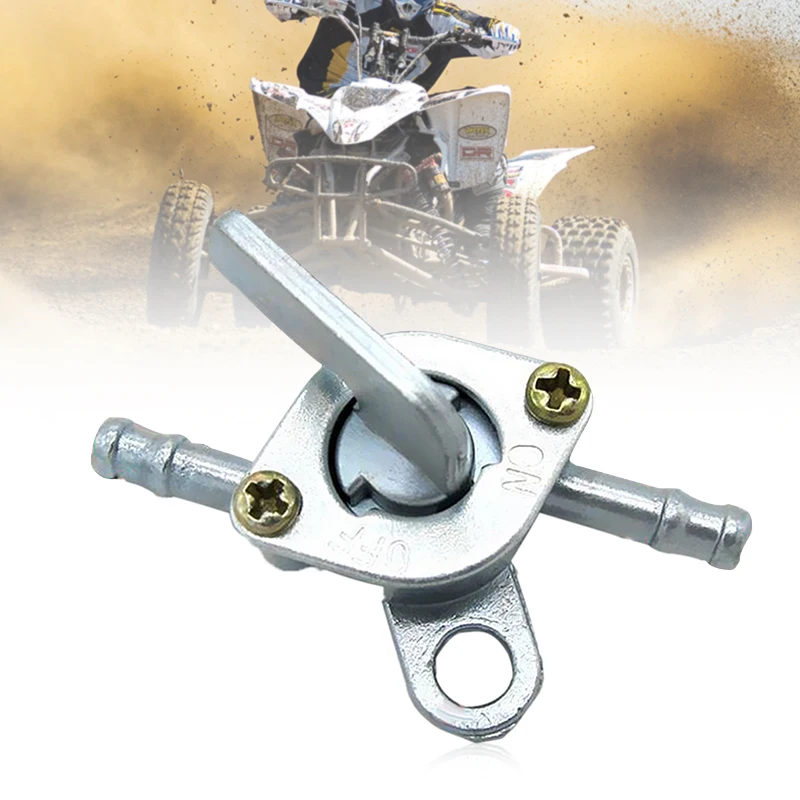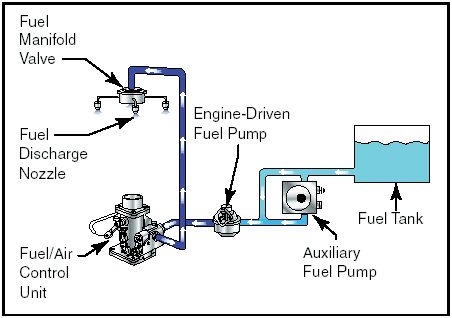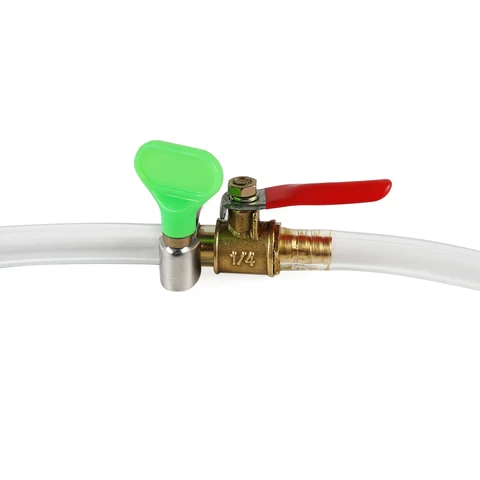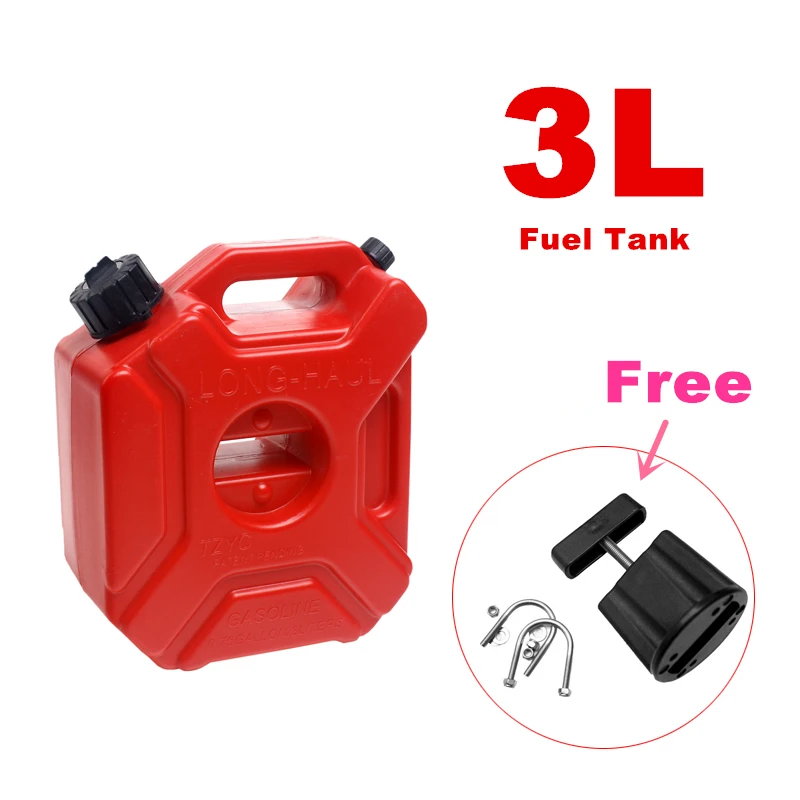Sometimes you need more fuel for a ride than the gas tank will hold, but you're probably wondering how you can safely bring more fuel with you. This post will tell you how to carry extra fuel on your ATV.
You'll need to determine how much extra fuel you need. Do you want it for emergencies or to extend your riding time?
4 to 10 gallons is what most people need, but there's a big difference there. If you only need 4 or 5, 10 would be overkill. If you need 8 to 10, then 4 or 5 will leave you seriously unprepared.
If you don't already know your ATV's gas mileage, you can feel it out over a few rides. Determine how much riding you can get out of your gas tank and then calculate how much riding you want to do beyond that, or in the event of an emergency.
While you could technically strap a 5-gallon gas jug to your ATV, it isn't safe. There are three ways to safely carry extra fuel on your ATV.
Fuel bottles are made of plastic or metal, and they are intended to be tough and unlikely to be damaged or punctured. They should also have leak-proof caps and overall design. You definitely want the gas to stay locked up tight. Research any fuel bottles you buy to ensure they are as tough and leakproof as they claim.
You will then put the fuel bottle in your ATV storage or aftermarket storage bag or box and pack it so you can make sure it doesn't roll or jostle around. There are fuel bottle holsters you can add to your ATV to securely hold your fuel bottles. You might prefer those.
Gas packs are tough containers intended to be mounted on your machine. This can be done with ratchet straps or fuel pack brackets. With fuel pack brackets, you can position the pack on the bracket and give it a simple twist to secure the pack. Using the gas pack and bracket method will be the most convenient option to carry fuel and other gear at the same time.
Factory gas tanks on ATVs usually only hold a few gallons. You can replace your gas tank for one with a higher capacity, but it is a complex job and unless you're very skilled with ATV repair, it'd be wiser to take it to a shop for this upgrade.
Any gas tank you'll replace yours with will have to be able to fit the space inside the machine. You also need to take weight and balance into consideration. The ATV was designed with the weight of the factory gas tank in mind.
If you were to try to replace the gas tank yourself, you'd need to empty the gas tank and make sure the machine is off and the key is removed.
You would disconnect the fuel lines to the tank, and potentially remove the seat and several other parts to get to the gas tank itself. You'd remove all the bolts and the gas tank itself. Then install the new gas tank and hook everything back up.
ATV are the core piece of riding gear for off-road riders
Find out the best look for you
Creativity and ingenuity are great, but carrying extra fuel on your ATV is not a place to use either. You do it the recommended way or it could get ugly.
You do it the recommended way or it could get ugly.
Use only containers built to carry fuel. Other containers can easily leak or be too readily damaged.
Don't carry gas on your person. No matter how hard you avoid leaks and damage, they can still happen, particularly in the event of an accident. Should the container become compromised, you want gas as far from your body as possible.
Unused gas breaks down and loses its effectiveness, even in the right containers. You could keep gas in an appropriate bottle or pack for short periods, but if it will be sitting for a month or more, at least add some fuel stabilizer to it to extend its life. Stabilizer manufacturers say it will keep gas viable for a year.
When you carry extra fuel on your ATV, you'll need to add checking the fuel bottle or gas pack to your maintenance list before and after every ride. Is it leaking or damaged? Is it just getting old?
Take them to the gas pump and set them on the ground.
Like when pumping gas into your car, avoid sparks. Turn off your vehicle and touch something metal before pumping the gas.
Don't smoke while filling a fuel container.
Don't put the gas container inside your vehicle. Fumes from it can buildup inside the vehicle, asphyxiating the occupants and creating a combustible environment.
Don't siphon the gas with your mouth. There are products that will siphon the gas from the container for you, and they're inexpensive and really easy to use.
HIT
ENDURO LIGHT Graphite
the most durable
458 EUR
HIT
ENDURO Camogrey
the most durable
657 EUR
ENDURO Graphite
the most durable
279 EUR
HIT
ENDURO Graphite
the most durable
657 EUR
-28%
AQUAMASTER-ZIP LIGHT Camogrey
with central zipper
598 EUR
430. 40 EUR
40 EUR
HIT
ENDURO LIGHT Camogrey
the most durable
458 EUR
-12%
AQUAMASTER LIGHT Red
reliability & comfort
438 EUR
386.20 EUR
NEODRY Black
17 EUR
11.90 EUR
ENDURO Camogrey
the most durable
279 EUR
AQUAMASTER Blue
reliability & comfort
647 EUR
-20%
HIT
AQUAMASTER Red
reliability & comfort
259 EUR
207.20 EUR
-40%
HIT
AQUAMASTER Orange
reliability & comfort
259 EUR
155.40 EUR
AQUAMASTER Red
reliability & comfort
677 EUR
ENDURO BF Camogrey
bootfoot waders
528 EUR
ALL SEASON Black
69 EUR
ENDURO BF Camogrey
bootfoot waders
329 EUR
MUDWAY Graphite
179 EUR
MUDWAY Camogrey
179 EUR
NEOSENSOR Camoarmy
12 EUR
8. 40 EUR
40 EUR
MUDWAY Red
179 EUR
Explore all
Select a country
United States | Canada | Germany | Lithuania | Latvia | Estonia
Afghanistan
Albania
Algeria
Andorra
Angola
Anguilla
Antarctica
Antigua and Barbuda
Argentina
Armenia
Aruba
Australia
Austria
Azerbaijan
show more
Bahamas
Bahrain
Bangladesh
Barbados
Belarus
Belgium
Belize
Benin
Bermuda
Bhutan
Bolivia
Bosnia and Herzegowina
Botswana
Bouvet Island
Brazil
British Indian Ocean Territory
British Virgin Islands
Brunei Darussalam
Bulgaria
Burkina Faso
Burundi
show more
Cambodia
Cameroon
Canada
Cape Verde
Cayman Islands
Central African Republic
Chad
Chile
China
Christmas Island
Cocos Islands
Colombia
Comoros
Congo
Cook Islands
Costa Rica
Cote D'ivoire
Croatia
Cuba
Cyprus
Czechia
show more
Denmark
Djibouti
Dominica
Dominican Republic
East Timor
Ecuador
Egypt
El Salvador
Equatorial Guinea
Eritrea
Estonia
Ethiopia
show more
Faeroe Islands
Falkland Islands
Fiji
Finland
France
French Antarctic
French Guiana
French Polynesia
show more
Gabon
Gambia
Georgia
Germany
Ghana
Gibraltar
Greece
Greenland
Grenada
Guadeloupe
Guatemala
Guinea
Guinea-bissau
Guyana
show more
Haiti
Heard and McDonald Islands
Honduras
Hong Kong
Hungary
Iceland
India
Indonesia
Iran
Iraq
Ireland
Israel
Italy
show more
Jamaica
Japan
Jordan
Kazakhstan
Kenya
Kiribati
Korea (North)
Korea (South)
Kuwait
Kyrgyzstan
show more
Laos
Latvia
Lebanon
Lesotho
Liberia
Libya
Liechtenstein
Lithuania
Luxembourg
show more
Macau
Macedonia
Madagascar
Malawi
Malaysia
Maldives
Mali
Malta
Marshall Islands
Martinique
Mauritania
Mauritius
Mayotte
Mexico
Micronesia
Moldova
Monaco
Mongolia
Montenegro
Montserrat
Morocco
Mozambique
Myanmar
show more
Namibia
Nauru
Nepal
Netherlands
Netherlands Antilles
New Caledonia
New Zealand
Nicaragua
Niger
Nigeria
Niue
Norfolk Island
Norway
show more
Pakistan
Palau
Palestine
Panama
Papua New Guinea
Paraguay
Peru
Philippines
Pitcairn Islands
Poland
Portugal
Puerto Rico
show more
Reunion
Romania
Russia
Rwanda
Saint Helena
Saint Kitts and Nevis
Saint Lucia
Saint Vincent and the Grenadines
Saint-Pierre and Miquelon
Samoa
San Marino
Saudi Arabia
Senegal
Serbia
Seychelles
Sierra Leone
Singapore
Slovakia
Slovenia
Solomon Islands
Somalia
South African Republic
South Georgia and the South Sandwich Islands
Spain
Sri Lanka
Sudan
Suriname
Svalbard and Jan Mayen Islands
Swaziland
Sweden
Switzerland
Syria
show more
Taiwan
Tajikistan
Tanzania
Thailand
Togo
Tokelau
Tonga
Trinidad and Tobago
Tunisia
Turkey
Turkmenistan
Turks Caicos Islands
Tuvalu
show more
U. S. Virgin Islands
S. Virgin Islands
United States
Uganda
Ukraine
United Arab Emirates
United Kingdom
Uruguay
Uzbekistan
show more
Vanuatu
Vatican City
Venezuela
Viet Nam
Wallis and Futuna Islands
Western Sahara
Zaire
Zambia
Zimbabwe
{{#DETAIL_PAGE_URL}} {{SECTION_NAME}} {{NAME}} {{/DETAIL_PAGE_URL}}
Color: {{COLOR}}
{{#IS_SIZE}} Size: {{{SIZE}}} {{/IS_SIZE}}
Quantity:
Only {{AVAILABLE_QUANTITY}} left
{{#SHOW_DISCOUNT_PRICE}}
{{{SUM_FULL_PRICE_FORMATED}}}
{{/SHOW_DISCOUNT_PRICE}}
{{{SUM_PRICE_FORMATED}}}
{{/GIFT}} {{#GIFT}}
{{/GIFT}} {{/EMPTY_BASKET}} {{#EMPTY_BASKET}}
Your basket is empty
{{/EMPTY_BASKET}}
{{/FREE_SHIPPING}} {{#FREE_SHIPPING}}Free shipping available
{{/FREE_SHIPPING}}{{^FREE_SHIPPING}}
{{{FREE_SHIPPING_PERCENT}}}%
{{/FREE_SHIPPING}}
{{{FREE_SHIPPING_PRICE}}}
CHECKOUT {{{PRICE_FORMATED}}}
{{/EMPTY_BASKET}} {{#EMPTY_BASKET}} {{/EMPTY_BASKET}}Continue shopping
Your cart:
Your basket is empty
 6130.000
6130.000 Installation of external additional fuel tanks VDB.6130.000 is designed to increase the flight range of Mi-8, Mi-8MTV, Mi-8AMT helicopters and their modifications. The use of VDB.6130.000 allows to increase the aircraft operation time by 5.5 - 6.1 flight hours (an additional distance of 1020-1070 km).
Non-resettable tanks, without explosion suppression system.
Equipment of VDTB helicopters does not interfere with their operation in any climatic conditions in the entire range of operating temperatures.
We are ready to offer two versions of tanks:
Shortened VDB is installed on all types of Mi-8, Mi-8MTV, Mi-8AMT helicopters and their modifications with a kerosene heater or air conditioning system on top. The use of this VDT allows the installation of a complete VDT system on cargo and passenger (VIP) helicopters manufactured in any configuration.
Order
 6130.000.
6130.000.
| Length | 3 600 mm |
| OD | 603 mm |
| Unit weight (without fuel) | 130 kg |
| Quantity | 2 tanks VDB 6130.200 |
| Total capacity | 1,690 l |
| Fuel capacity (for helicopters with larger fuel tanks and VDTB) | 3 337 kg |
| Flight range and duration: for helicopters with a takeoff weight of 11.  1t 1t for helicopters with a takeoff weight of 13t | 1,070 km, 6.1 hours 1,020 km, 5.5 hours |
| Fuel consumption | by gravity into the main hanging tanks |
| Output control | (tank full, less than 510 liters left, tank empty) |
| Resource | 3,000 hours |
| Service life | 25 years |
| Mounting (dismantling) time | Less than 3 hours |
When installing the VDTB on a helicopter, the neutral gas system must be turned off, special farms and EEDs must be dismantled. Depending on the flight task, tanks and pylons can be temporarily dismantled.
Work location (operator's choice):
Completion time: 7 days
Technical staff: 5 people
Order
Recently, the most frequent question from our customers sounds something like this:
- I want to buy a towbar, a protective arc and thresholds of your production, do they need to be made as changes to the vehicle design and what will happen to me if the traffic police stop me?
Let's try to figure out if it's necessary or not?
The only document confirming the vehicle's compliance with the requirements of the technical regulations of the Customs Union (TR TS 018/2011) "On the safety of wheeled vehicles", adopted by the Decision of the Commission of the Customs Union dated 09. 12.2011 No. 877 (as amended) is the "Approval of the Vehicle Type Funds” (hereinafter – OTTS).
After passing all the tests and checks for compliance with the requirements of TR CU 018/2011, an accredited certification body issues an OTTS for a certain make and model, this document is issued for a certain batch of vehicles indicating the VIN numbers (*********** *001 - **************999) and lists all equipment approved for installation (if not installed when sold by the manufacturer) and use on public roads without registration of modifications to the vehicle design. Simply put: everything that is inscribed in a specific OTTS is already allowed for operation on a given batch of cars.
Example: 2019 Pajero Sport III
On page No. 6 in the appendix we find the interesting list of approved equipment for this type of vehicle:
Based on the information specified in the documents above, the car (included in the batch included in the OTTS) can be used with a tow bar (TSU), side steps, lower protection of the front and rear bumpers. Naturally, the OTTS does not specify the manufacturer of these structures and it can be anything: the main condition is the presence of a certificate/declaration of conformity for the manufactured products or the presence of a document confirming that there is no need to issue a certificate/declaration of conformity.
Naturally, the OTTS does not specify the manufacturer of these structures and it can be anything: the main condition is the presence of a certificate/declaration of conformity for the manufactured products or the presence of a document confirming that there is no need to issue a certificate/declaration of conformity.
And now, the question is: where can I get a certificate of conformity for a towbar, an arc, thresholds purchased from Pajero Shop? We answer: we do not have a certificate of conformity for products, because we do not mass-produce it, as stated in the officially issued conclusion of VNIIS:
What is the opinion of VNIIS? - A response to a supplier or manufacturer of products about whether the product is subject to mandatory certification or declaration is also referred to as a "rejection letter". This document is drawn up taking into account the requirements of regulatory documents within the framework of the current technical regulations of the Customs Union, and indicates that the products specified in it are not subject to mandatory confirmation of conformity.